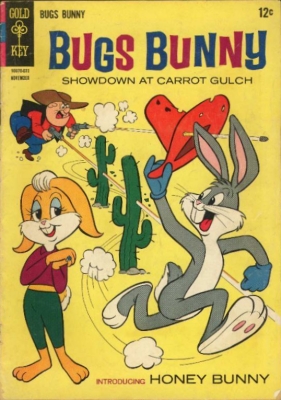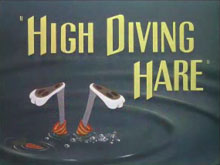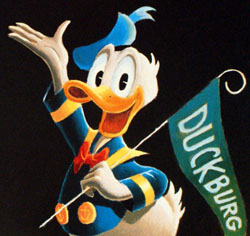 Bugs Bunny’s Girlfriend. There was a 1945 New York Times newspaper article where animation legend Friz Freleng was quoted as saying “We don’t want to give him (Bugs Bunny) a girlfriend”. In 1990, animation historian Joe Adamson asked Freleng about that quote.
Bugs Bunny’s Girlfriend. There was a 1945 New York Times newspaper article where animation legend Friz Freleng was quoted as saying “We don’t want to give him (Bugs Bunny) a girlfriend”. In 1990, animation historian Joe Adamson asked Freleng about that quote.
Freleng replied, “I thought it would just detract from him, really. I didn’t think of him in terms of any sexual relationship at all. He was a fantasy character as far as I was concerned. I didn’t want to make him too human. I didn’t want him to have the same weaknesses that people have. And what good would a female character do for Bugs? I don’t think it would add anything. You start making a family man out of him and he’s not Bugs Bunny anymore. He’s not a human and he’s not a rabbit either. I don’t think he belongs in this world, so I can’t relate him to what goes on here. I think of him living in a complete fantasy world.”
Flip Vs. Mickey. Animation legend Grim Natwick in 1975 said, “If you ever picked him apart (Ub Iwerks’ Flip the Frog), he was designed very much like Mickey Mouse except he had a blunt nose and he wore a funny hat. Otherwise they were almost the same characters, which helped me because after drawing Flip for a while, when I finally did go to Disney’s, Mickey came very easy. I never had any gripe with Disney’s. It was a great place to work, terrific experience, and I believe, the greatest college of animation in the world. Disney had only one rule: whatever we did had to be better than anybody else could do it, even if you had to animate it nine times, as I once did.”
Disney Vs. Warners. In 1990 with the release of “Tiny Toons” television series, producer and filmmaker Steven Spielberg told a reporter: “As a kid, I remember my dad and I would go see the Disney cartoons which were wonderful. But we only really fell out of our chairs when we were watching Bugs and Elmer Fudd, or Wile E. Coyote and the Road Runner. You could hear the audience laughing hysterically. My father and I laughed shoulder to shoulder. We would die laughing. Disney made you feel good, but Warner toons cracked you up.”
Open the Door, Richard. In 1990 as Bugs Bunny was celebrating his 50th anniversary, animation legend Chuck Jones predicted that Bugs would still be making people laugh in the next fifty years because “our stuff appears to have a certain timeless quality to it. From the moment we started working on a picture until it hit the theaters, it might take three years, so we studiously avoided anything relating to now. Once in a while something would sneak in.
 “In High Diving Hare (1949), Yosemite Sam kept trying to make Bugs do a 100-foot dive from atop a ladder into a bucket of water. But Bugs kept thwarting him. Sam would always be the one that fell off. At some point, Bugs puts a doorway on the diving board. Sam hammers on it, saying, ‘Open the door. Open the door.’ Then he turns to the audience and says, ‘You notice I didn’t say Richard’. Well, there was a very popular song two years earlier called ‘Open the door, Richard’. Today, kids see this film and say, ‘Who’s Richard?’ Well, that was just one of those slips of the sort that we fortunately usually avoided.”
“In High Diving Hare (1949), Yosemite Sam kept trying to make Bugs do a 100-foot dive from atop a ladder into a bucket of water. But Bugs kept thwarting him. Sam would always be the one that fell off. At some point, Bugs puts a doorway on the diving board. Sam hammers on it, saying, ‘Open the door. Open the door.’ Then he turns to the audience and says, ‘You notice I didn’t say Richard’. Well, there was a very popular song two years earlier called ‘Open the door, Richard’. Today, kids see this film and say, ‘Who’s Richard?’ Well, that was just one of those slips of the sort that we fortunately usually avoided.”
In 1947, the song was the number-one song on Billboard’s “Honor Roll of Hits” for five different artists who all recorded it in the same year. It was a novelty record sensation. It was based on an old vaudeville routine, usually by Black performers like Pigmeat Markham, of a ragged, drunken character knocking on a door and yelling for Richard to let him in. The character “knows” that Richard is inside but Richard won’t come to the door for some reason.
Gaston’s Hair. In 1994, Andreas Deja talking about working on the villain in Disney’s animated feature “Beauty and the Beast” said, “There was a scene with Gaston that was a real pain. It was more of a technical problem, when he’s opening up his shirt and every inch of him is covered with hair. I didn’t have time to animate that scene myself, so I gave it to Joe Haidar. He animated it and did an okay job, but after Gaston opened up his shirt, the hair was drifting.
“It just looked weird, so I took the scene and modified it a little bit and tried curly hair. We shot that and the hair was crawling all over the place. Then everybody did their own version of chest hair. Some had little fur, some had little stubs, some had wiry things. There were all kinds of weird ideas. Of course, it got carried away. People took it as a joke. I talked with the effects department who tried something with short curls. We shot it and it was going ‘bzzzzz’.
“We had to take their work, cut it out, re-peg it and everything. It was an absolute nightmare. The scene just didn’t want to work. It was one of Gaston’s funniest scenes, so it better be right! Eventually, with a combination of effects people and us, we did it. It still crawls a little bit, but not to the point where you go ‘Ooouuh, what’s THAT?’”
 Duck Talk. Comic book Legend Carl Barks worked as a storyman on Donald Duck cartoons at the Disney Studio, often teamed with Jack Hannah. At NEWCON in 1976, Barks talked about the challenges of working with Clarence Nash who supplied the voice for Donald.
Duck Talk. Comic book Legend Carl Barks worked as a storyman on Donald Duck cartoons at the Disney Studio, often teamed with Jack Hannah. At NEWCON in 1976, Barks talked about the challenges of working with Clarence Nash who supplied the voice for Donald.
Barks said, “Donald evolved out of Ducky Nash’s way of saying things in duck talk. He would quack, quack, quack and blow words out of the side of his mouth or something and that created Donald. They just wanted some character that would fit the crazy sound that Clarence Nash was making. He used to come in on the story meetings. We had a lot of dialogue that he had to practice. And it would determine, sometimes, what the dialogue would finally be, whether or not he could say the words. Of course, none of us could understand him even when he said, ‘Well, I said that all right.”
Clampett’s Dilemma. Here’s another story Bob Clampett told me but I never got around to verifying. He hesitated to tell the woman he went on a blind date with that he made animated cartoons because he felt she might not consider that appropriate for a grown man. Finally, after other dates, he confessed the secret to the woman he had grown to love.
Sody laughed. “You make animated cartoons? My favorite song is from an animated cartoon. It’s called ‘There’s food around the corner’.”
“That’s your favorite song?” exclaimed Bob. “Why I wrote that song! It’s from one of my cartoons An Itch In Time (1943)!”
“Well,” replied Sody, “Then I will marry you!”


 Jim Korkis is an internationally respected animation historian who in recent years has devoted his attention to the many worlds of Disney. He was a columnist for a variety of animation magazines. With his former writing partner, John Cawley, he authored several animation related books including The Encyclopedia of Cartoon Superstars, How to Create Animation, Cartoon Confidential and Get Animated’s Animation Art Buyer’s Guide. He taught animation classes at the Disney Institute in Florida as well as instructing classes on acting and animation history for Disney Feature Animation: Florida.
Jim Korkis is an internationally respected animation historian who in recent years has devoted his attention to the many worlds of Disney. He was a columnist for a variety of animation magazines. With his former writing partner, John Cawley, he authored several animation related books including The Encyclopedia of Cartoon Superstars, How to Create Animation, Cartoon Confidential and Get Animated’s Animation Art Buyer’s Guide. He taught animation classes at the Disney Institute in Florida as well as instructing classes on acting and animation history for Disney Feature Animation: Florida.




















































Another contemporary reference that keeps popping up is “Yehudi”. Very few people watching today that referred to the catchphrase “Who’s Yehudi” started by Jerry Colonna when violinist Yehudi Menuhin appeared on Bob Hope’s radio show.
Yehudi references can be seen in Hollywood Steps Out (Avery, 1941) in which an invisible figure is sitting next to Colonna and is identified by Jerry as Yehudi, and in Farm Frolics (Clampett, 1941) in which an owl says “Who’s Yehudi?”. Another reference comes in Crazy Cruise (Avery/Clampett, 1942), in which an invisible battleship, the S.S. Yehudi, is seen. There is also the Club Yahoodi in Lights Fantastic (Freleng, 1942), which does not have much of anything.
The other one that puzzled me as a kid was Hurdy Gurdy Hare (McKimson, 1950) when at the end Bugs says, “I sure hope Petrillo doesn’t hear about this!” I later found out this was James Petrillo, President of the American Federation of Musicians union. Apparently a strike was going on when that cartoon was being produced.
I recall that “Who’s Yehudi?” was also refferenced in the early Andy Panda short, “Mouse Trappers” (1941).
OK, now I want to see some of those failed (and joke) Gaston hair attempts…
Looney Tunes and Merrie Melodies actually do use contemporary references fairly frequently; the key is that most of the time, if you don’t get the reference, you can still enjoy the gag (or, at least, not be pulled out of the film by a gag that you don’t understand). I had no idea who Jerry Colonna was when I was a kid, but I still found the characters in “Greetings, Bait” to be funny (though the title’s pun obviously eluded me). “You notice I didn’t say Richard” fails not because it’s a pop-culture reference, but because if you don’t get the reference, you realize that there’s a gag there that you’re not getting.
Friz did give the girlfriend thing a shot once, in “Hare Splitter”, while sex also was the end gag for “Bugs Bunny Nips the Nips”. In both cases we iris out on a rabbit in sexual frenzy — not the type of image J.L. probably would have wanted to make a habit, given where part of the studio’s target audience was, even if the cartoons were also being made for adults to enjoy (and Chuck Jones’ end gag for “A Feather In His Hare” played on the costs to Bugs of non-cautious sexual frenzy. Good enough reason in the future for him to steer clear of girlfriends).
Never mind a girlfriend. How about Hold the Lion , Please (1941 Jones) where we meet Mrs Bugs Bunny?
https://www.youtube.com/watch?v=vKEFI9_eLDI
I didn’t include that one, because Bugs isn’t exactly in romantic rapture in the final gag of that one (he’s way more excited about kissing the mechanical rabbit at the end of “The Gray-Hounded Hare”).
@J LEE
That’s a valid point!
In part though I was referencing Freleng’s statement above when he said, “You start making a family man out of him and he’s not Bugs Bunny anymore.”
Jones’ cartoon would seem to validate that. After giving the lion a good run for his money the appearance of Mrs Bugs just knocked the wind out of him.
The one that puzzled me way back when was the mother gorilla at the end of BABY BOTTLENECK, complaining into the telephone, “Mr. Anthony, I have a problem!”
I remember the “Richard” gag being scissored from late network airings of that cartoon.
That one went right over my head as a kid too. There was also the reference in Ain’t That Ducky (1945 Freleng) where the crying little duck with the briefcase yells at Daffy “AAH, KEEP YOUR HANDS OFF, MISTER ANTHONY!”
Then I learned about Old Time Radio’s “Ask Mr Anthony” and “The Goodwill Hour” (later the John J Anthony Program):
http://knowotr.blogspot.com/2008/09/john-j-anthony-1902-70.html
You can listen to an episode here:
https://ia700409.us.archive.org/11/items/Singles_And_Doubles_Singles_H-K/45-04-04_xxx_John_J_Anthony_-_Advice.mp3
The one reference that confused me as a kid was the line at the end of “Falling Hare” when the plane runs out of gas because “you know how it is with these A cards.” I thought it had something to do with “Flying A,” a brand of gasoline that was still around in the early 1960s.
I did eventually find out about the various gas-rationing cards of WWII, and how the “A” card was for most civilian drivers and was the lowest (4 gallons a week), There were also “B” cards for business owners (who got more), “C” stickers for people who needed their cars for “emergency” uses (e.g. doctors or clergymen), and “X” stickers for those who needed unlimited gasoline (presumably politicians and their rich contributors).
There was also the bit in “Russian Rhapsody” when the gremlins switch the card on Hitler’s plane from a C card to an A Card.
“politicians and their rich contributors”? Seriously? Yeah there was a scandal about Congressmen getting X cards so do you think for a minute that some stereotypical “rich contributor” could get away with an X card?
Don’t apply 2014 cynicism to World War 2. In this 1942 article from LIFE magazine there were actually Congressmen rejecting X cards and applying for A & B cards.
http://tinyurl.com/p76od69
“politicians and their rich contributors”? Seriously? Yeah there was a scandal about Congressmen getting X cards so do you think for a minute that some stereotypical “rich contributor” could get away with an X card?
Don’t apply 2014 cynicism to World War 2.
I’m sure a lot of us had that in the back of our heads just thinking about it.
“I’m sure a lot of us had that in the back of our heads just thinking about it.”
If you all did it was based off of ignorance. Since gas ration stickers were in fact stuck to your window then all the world could see if you were getting over with an X “card”. Kind of hard to hush up.
If you all did it was based off of ignorance. Since gas ration stickers were in fact stuck to your window then all the world could see if you were getting over with an X “card”. Kind of hard to hush up.
I blame postmodern cynicism for what the internet has done to us. We need to push pre-postmodernism in our lives!
Some years ago, my best friend Mary Lou Wallace (who knows a LOT about showbiz history in its various venues), told me that she once went to a cartoon show at a movie theater. On that day, the theater happened to show HIGH DIVING HARE. The moment came when Sam turned to the audience and said, “You notice I didn’t say ‘Richard!'” Mary Lou laughed at the song title reference–and she was the ONLY ONE in that whole theater who laughed!
Recall my mom had a copy of that record in her collection I got to hear two decades back!
The Richard reference Yosemite Sam made always cracked me up even before I got the reference.
I never realized that Sam was saying “Richard.” I thought he said “wretched,” and asking if we noticed he didn’t say it, as if “wretched” was being used as a curse word and he was showing self-control, or some such.
Convoluted perhaps, but that’s how I always took it.
That quote from Friz Freleng seems to invalidate the entire premise of the Cartoon Network’s Looney Tunes Show, doesn’t it? He wasn’t Bugs Bunny anymore…he was Seinfeld in a Bugs Bunny suit.
There’s also a Cab Calloway song from May, 1940 entitled “Who’s Yehoodi?”.